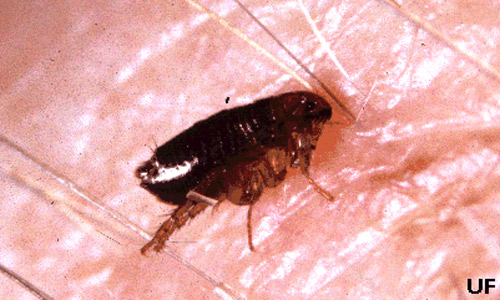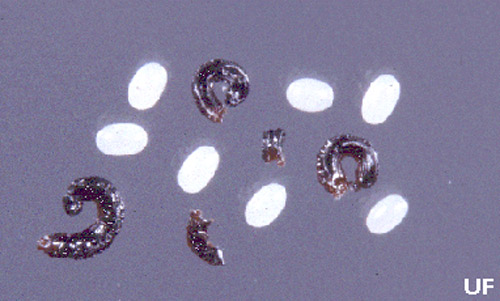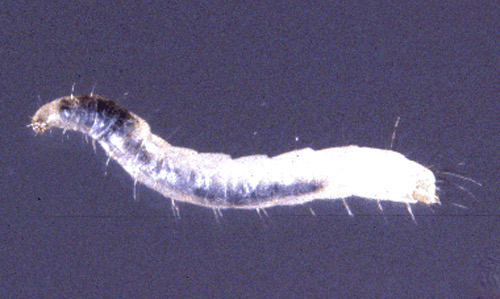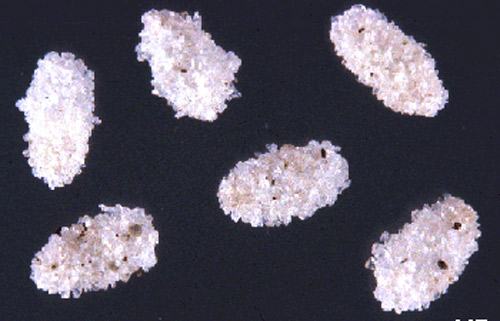cat flea - Ctenocephalides felis (Bouché) (original) (raw)
common name: cat flea
scientific name: Ctenocephalides felis (Bouché) (Insecta: Siphonaptera: Pulicidae)
Introduction - Distribution - Description - Life Cycle - Medical and Economic Significance - Action Threshold - Management - Selected References
Introduction (Back to Top)
There are over 2,000 described species of fleas. The most common domestic flea is the cat flea, Ctenocephalides felis (Bouché). The adult cat flea, unlike many other fleas, remains on the host. Adults require a fresh blood meal in order to reproduce.
Figure 1. Adult cat flea, Ctenocephalides felis (Bouché). Photograph by University of Florida.
The dog flea, Ctenocephalides canis (Curtis), appears similar to the cat flea, but is rarely found in the United States. Cat fleas are commonly found on both cats and dogs in North America, while dog fleas are found in Europe. The two species are distinguished by a slight morphological difference which is detectable only under high magnification.
Distribution (Back to Top)
Although it exists worldwide, the cat flea is most commonly found in the United States, in and around homes with pets.
Description (Back to Top)
Adults: Adults are stimulated to emerge by vibration or an increase in carbon dioxide. They are about one to three mm in size, reddish-brown to black in color, wingless, and are laterally compressed. They possess powerful hind legs which allow for running and jumping through hair, fur, and feathers. Adult cat fleas require fresh blood to produce eggs. This is the only stage in the cat flea life cycle when the fleas live on the pet. Adults live four to 25 days.
Eggs: Cat flea eggs are laid at the rate of up to one egg per hour. They are oval, smooth, and about 0.5 mm in size. Due to their dry, smooth surface, the eggs easily fall out of the animal's hair. Though otherwise visible, the white eggs are nearly impossible to see against surfaces such as carpet, bedding, and lawn. It is here where the eggs will remain until the larvae emerge.
Figure 2. Cat flea eggs (white ovals) and feces, Ctenocephalides felis (Bouché). Photograph by University of Florida.
Larvae: Within two days of oviposition, wormlike larvae hatch from the eggs. They range from 1.5 to 5 mm in length. This stage lasts five to 15 days. Larvae lack eyes, legs, are covered with few hairs, and possess dark guts, visible through their thin translucent exoskeleton. Larvae feed on almost any organic debris in the floor covering, but their main dietary component is dried adult cat flea fecal matter. Adult flea feces, also known as "flea dirt", consist of relatively undigested blood which dries and falls from the pet to serve as food for the newly hatched larvae. The larvae prefer to develop in areas protected from rainfall, irrigation, and sunlight, where the relative humidity is at least 75 percent and the temperature is 70 to 90°F.
Figure 3. Larva of the cat flea, Ctenocephalides felis (Bouché). Photograph by University of Florida.
Pupae: Before becoming adults, the larvae spin silk cocoons in which they will develop. Because of the sticky outer surface of the cocoons, dirt and debris are attracted to them and provide camouflage. The pupae remain in the cocoons until they have fully developed into adult fleas.
Figure 4. Pupae of the cat flea, Ctenocephalides felis (Bouché). Photograph by University of Florida.
Life Cycle (Back to Top)
The cat flea life cycle is one of complete metamorphosis, involving the stages of an egg, larva, pupa, and adult. This cycle usually lasts 30 to 75 days, yet may vary due to external factors, such as temperature and humidity.
Medical and Economic Significance (Back to Top)
Cat fleas are capable of transmitting plague and murine typhus to humans, though such reports are rare. There are also varied allergic responses to their bites, depending upon the sensitivity of the host. Cat fleas serve as the intermediate host to an intestinal parasite, the dog tapeworm (Dipylidium caninum), which is transmitted to the pet when a flea carrying a tapeworm cyst is ingested. Mostly, fleas simply act as a nuisance, since they feed on any warm-blooded animal. A common problem for the host is flea allergy dermatitis (FAD), which pet owners in the United States annually spend millions of dollars to treat. An estimated 2.8billionisspentannuallyonflea−relatedveterinarianbills.Petownersspendanestimated2.8 billion is spent annually on flea-related veterinarian bills. Pet owners spend an estimated 2.8billionisspentannuallyonflea−relatedveterinarianbills.Petownersspendanestimated1.6 billion annually for flea treatment through groomers, 4billionforoverthecountertreatments,and4 billion for over the counter treatments, and 4billionforoverthecountertreatments,and348 million for professional flea control.
Action Threshold (Back to Top)
Fleas can be detected early on by observing the behavior of the pet (i.e.. noticing the pet scratching). Flea allergy dermatitis is a costly and uncomfortable ailment for both animals and humans, and early detection and treatment is the key to minimization of suffering. Though cat fleas can act as vectors for disease, action is usually taken due to the great annoyance caused by the itching and biting of the fleas, rather than for health purposes.
Management (Back to Top)
Cultural control. In order to effectively control an infestation, fleas must be removed from the pet, the home and the yard. Removal of fleas from the animal alone is futile. Immature fleas which have developed into adults off the animal simply jump on, causing subsequent reinfestation. Flea combs may be used to treat the pet, yet they only remove ten to sixty percent of the fleas. However, by shampooing the animal, the dried blood and skin flakes which provide food for the larvae are removed.
Scientific evidence regarding dietary supplementation with vitamin B, Brewer’s Yeast or garlic suggest these methods are of little value. Scientific evidence has also shown that ultrasonic and insecticidal flea collars are not very effective. Cedar chips and leaves from wax myrtles have repellent properties according to some homeowners, but have not been scientifically proven.
If possible, control access of feral animals, such as skunks, opossums, raccoons and cats to your yard as they bring new fleas with them. Light traps placed around the home, especially where the pet frequents, may collect fleas upon emergence from their cocoons. Yet it is doubtful that this type of trap will attract fleas off the pet.
Chemical control. Advances in flea adulticides are topical treatments, such as imidacloprid or fipronil. When using a pesticide, always consult the label. Insect growth regulators (IGR) and insect development inhibitors (IDI), administered as a daily or monthly dose, will disrupt egg and larval development but not kill adult fleas. Methoprene and pyriproxyfen are active ingredients of IGRs sold through veterinarians and pest control operators which are available in sprays and fleas collars. Lufenuron, an IDI sold through veterinarians, is orally administered to the pet.
Insecticidal shampoos contain certain pesticides such as pyrethrins, carbamates, and citrus peel derivatives. Pennyroyal oil, another natural product, is also available in shampoos. However, pulegone, the active ingredient in the oil has dose related toxicity to mammals and may induce lethargy, vomiting, diarrhea, nose bleeds, seizures and possibly death due to liver failure.
For effective control, the home must also be treated, primarily in areas most frequented by the animal as the eggs and larvae are developing here. This can be done by vacuuming, washing bedding and rugs, and using sprays containing insecticides on the carpet. However, vacuuming will only remove eggs and food sources from the carpet. Larvae curl up around carpet fibers and pupae stick to the carpet. It is important to restrict pet access from areas that are hard to treat, such as children’s playrooms, crowded garages and work areas. Sheds and dog houses should be treated the same way and at the same time as the home.
Borate carpet treatment, applied either by the home owner or a professional, works as an intestinal poison upon ingestion by the flea larvae. Diatomaceous earth has been used as a chafing agent to control larvae in carpets, but it contains silica which is known to cause lung disease in humans if inhaled in excessive quantities.
To treat the outdoors, pyrethroids may be sprayed in dry shaded areas which the animal frequents, as well as insect growth regulators such as pyriproxyfen and fenoxycarb, which are the most effective outdoor treatments. Methoprene is also commonly used outdoors, but is not stable in sunlight. Since larvae prefer shaded, dry areas, spraying the entire yard is wasteful and irresponsible. For outdoor areas which are difficult to treat (i.e. under decks), pet access should be restricted. Outdoor treatment is primarily used in severe cases of flea infestation and may not be necessary if fleas are controlled on the pet and in the home.
Biological control. The use of the beneficial nematode Steinernema carpocapsae has been investigated in several areas around the United States. These nematodes are applied to the lawn as a spray to destroy the flea larvae by parasitizing them. If label directions are followed carefully, this should reduce flea populations. However, these nematodes work best in sandy soils and lose effectiveness if such soil is not present.
Selected References (Back to Top)
- Dryden MW, Reid BL. 1996. Insecticide susceptibility of cat flea (Siphonaptera: Pulicidae) pupae. Journal of Economic Entomology 89: 421-427.
- El-Gazzar LM, Milio J, Koehler PG, Patterson RS. 1986. Insecticide resistance in the cat flea (Siphonaptera: Pulicidae). Journal of Economic Entomology 79: 132-134.
- El-Gazzar LM, Patterson RS, Koehler PG. 1988. Comparisons of cat flea (Siphonaptera: Pulicidae) adult and larval insecticide susceptibility. Florida Entomologist 71: 359-363.
- Hinkle NC, Koehler PG, Patterson RS. 1995. Larvicidal effects of boric acid and disodium octaborate tetrahydrate to cat fleas (Siphonaptera: Pulicidae). Journal of Medical Entomology 32: 424-427.
- Hinkle NC, Wadleigh RW, Koehler PG, Patterson RS. 1995. Mechanisms of insecticide resistance n a strain of cat fleas (Siphonaptera: Pulicidae). Journal of Economic Entomology 30: 43-48.
- Hinkle NC, Koehler PG, Patterson RS. 1995. Residual effectiveness of insect growth regulators applied to carpet for control of cat flea (Siphonaptera: Pulicidae) larvae. Journal of Economic Entomology 88: 903-906.
- Kern WH Jr, Koehler PG, Patterson RS. 1992. Diel patterns of cat flea (Siphonaptera: Pulicidae) egg and fecal decomposition. Journal of Medical Entomology 29: 203-206.
- Koehler PG, Moye HA. 1995. Airborne insecticide residues after broadcast application for cat flea (Siphonaptera: Pulicidae) control. Journal of Economic Entomology 88: 1684-1689.
- Lemke LA, Koehler PG, Patterson RS. 1989. Susceptibility of the cat flea (Siphonaptera: Pulicidae) to pyrethroids. Journal of Economic Entomology 82: 839-841.
- Moser BA, Koehler PG, Patterson RS. 1992. Effect of methoprene and diflubenzuron on larval development of the cat flea (Siphonaptera: Pulicidae). Journal of Economic Entomology 85: 112-116.



